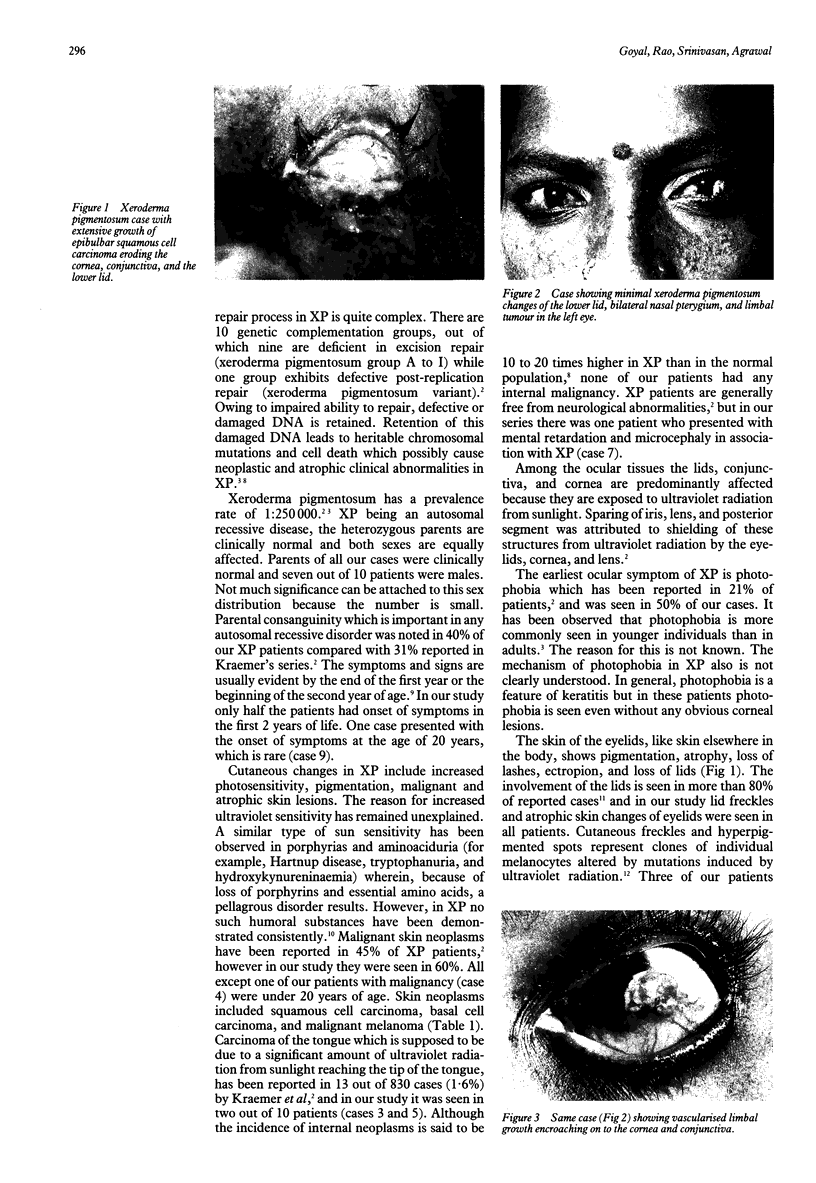Abstract
Xeroderma pigmentosum (XP) is a rare genetic disease characterised by defective DNA repair leading to clinical and cellular hypersensitivity to ultraviolet radiation. The oculocutaneous features of 10 patients with XP were studied retrospectively. General features included parental consanguinity (40%), familiarity (60%), onset of symptoms in first 2 years (50%), malignant skin neoplasms (60%), and carcinoma of the tongue (20%). Among the ocular features, 50% of patients presented with photophobia. Lid freckles or atrophic skin lesions were seen in all patients. Lower lid tumours were seen in 30%, chronic conjunctival congestion in 40%, corneal opacification in 40%, squamous cell carcinoma of limbus in 20%, bilateral pterygium in 40%, and visual impairment in 50%. The clinical features (ocular and cutaneous) of the cases are discussed.
Full text
PDF


Images in this article
Selected References
These references are in PubMed. This may not be the complete list of references from this article.
- Applegate L. A., Ley R. D. DNA damage is involved in the induction of opacification and neovascularization of the cornea by ultraviolet radiation. Exp Eye Res. 1991 Apr;52(4):493–497. doi: 10.1016/0014-4835(91)90047-i. [DOI] [PubMed] [Google Scholar]
- Cleaver J. E. Defective repair replication of DNA in xeroderma pigmentosum. Nature. 1968 May 18;218(5142):652–656. doi: 10.1038/218652a0. [DOI] [PubMed] [Google Scholar]
- Fischer E., Thielmann H. W., Neundörfer B., Rentsch F. J., Edler L., Jung E. G. Xeroderma pigmentosum patients from Germany: clinical symptoms and DNA repair characteristics. Arch Dermatol Res. 1982;274(3-4):229–247. doi: 10.1007/BF00403726. [DOI] [PubMed] [Google Scholar]
- Hertle R. W., Durso F., Metzler J. P., Varsa E. W. Epibulbar squamous cell carcinomas in brothers with Xeroderma pigmentosa. J Pediatr Ophthalmol Strabismus. 1991 Nov-Dec;28(6):350–353. doi: 10.3928/0191-3913-19911101-15. [DOI] [PubMed] [Google Scholar]
- Johnson M. W., Skuta G. L., Kincaid M. C., Nelson C. C., Wolter J. R. Malignant melanoma of the iris in xeroderma pigmentosum. Arch Ophthalmol. 1989 Mar;107(3):402–407. doi: 10.1001/archopht.1989.01070010412036. [DOI] [PubMed] [Google Scholar]
- Jung E. G. Xeroderma pigmentosum. Int J Dermatol. 1986 Dec;25(10):629–633. doi: 10.1111/j.1365-4362.1986.tb04522.x. [DOI] [PubMed] [Google Scholar]
- Kraemer K. H., Lee M. M., Scotto J. Xeroderma pigmentosum. Cutaneous, ocular, and neurologic abnormalities in 830 published cases. Arch Dermatol. 1987 Feb;123(2):241–250. doi: 10.1001/archderm.123.2.241. [DOI] [PubMed] [Google Scholar]
- Newsome D. A., Kraemer K. H., Robbins J. H. Repair of DNA in xeroderma pigmentosum conjunctiva. Arch Ophthalmol. 1975 Aug;93(8):660–662. doi: 10.1001/archopht.1975.01010020626012. [DOI] [PubMed] [Google Scholar]
- Reed W. B., Landing B., Sugarman G., Cleaver J. E., Melnyk J. Xeroderma pigmentosum. Clinical and laboratory investigation of its basic defect. JAMA. 1969 Mar 17;207(11):2073–2079. doi: 10.1001/jama.207.11.2073. [DOI] [PubMed] [Google Scholar]
- Robbins J. H., Kraemer K. H., Lutzner M. A., Festoff B. W., Coon H. G. Xeroderma pigmentosum. An inherited diseases with sun sensitivity, multiple cutaneous neoplasms, and abnormal DNA repair. Ann Intern Med. 1974 Feb;80(2):221–248. doi: 10.7326/0003-4819-80-2-221. [DOI] [PubMed] [Google Scholar]
- Robbins J. H. Significance of repair of human DNA: evidence from studies of xeroderma pigmentosum. J Natl Cancer Inst. 1978 Sep;61(3):645–656. [PubMed] [Google Scholar]
- Robbins J. H. Xeroderma pigmentosum. Defective DNA repair causes skin cancer and neurodegeneration. JAMA. 1988 Jul 15;260(3):384–388. doi: 10.1001/jama.260.3.384. [DOI] [PubMed] [Google Scholar]





